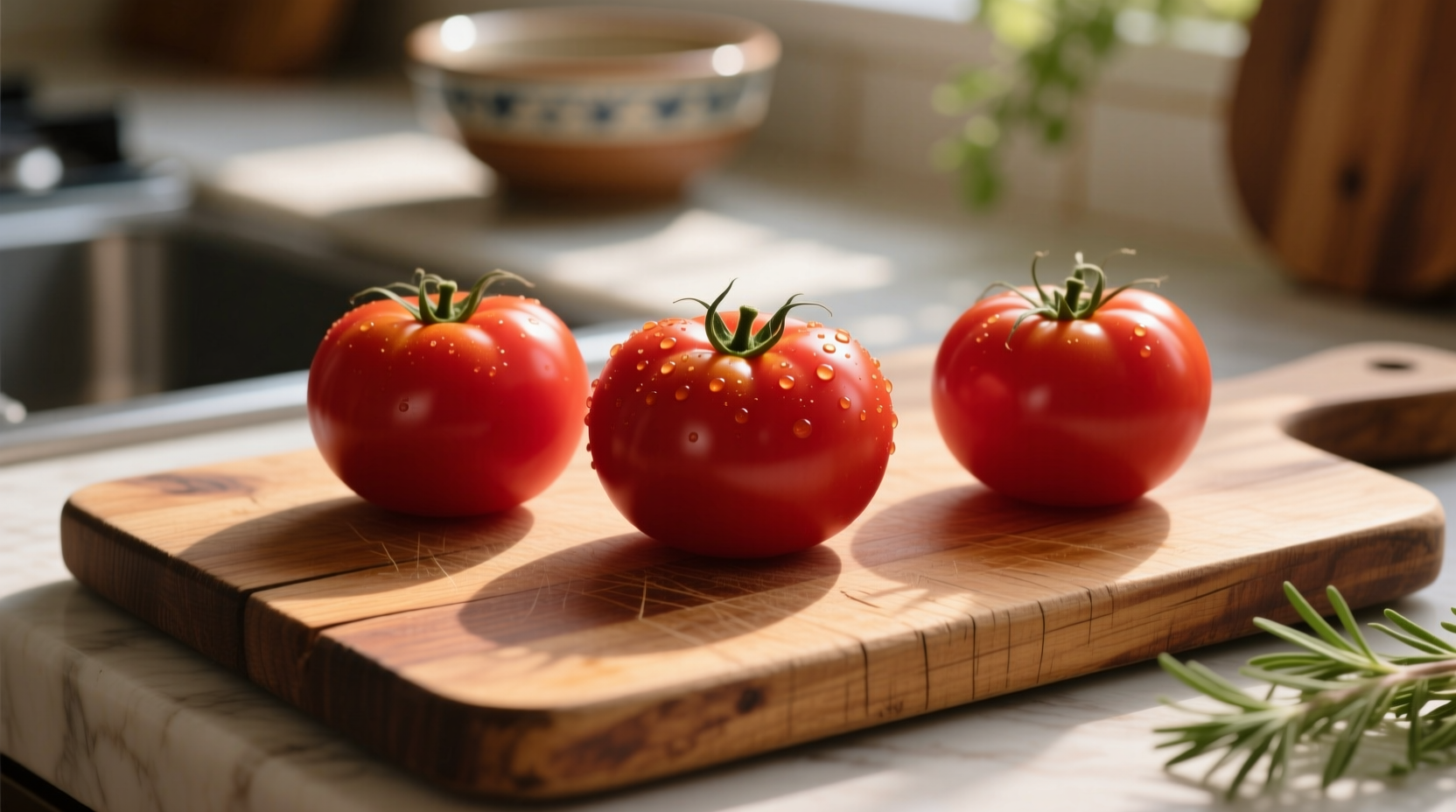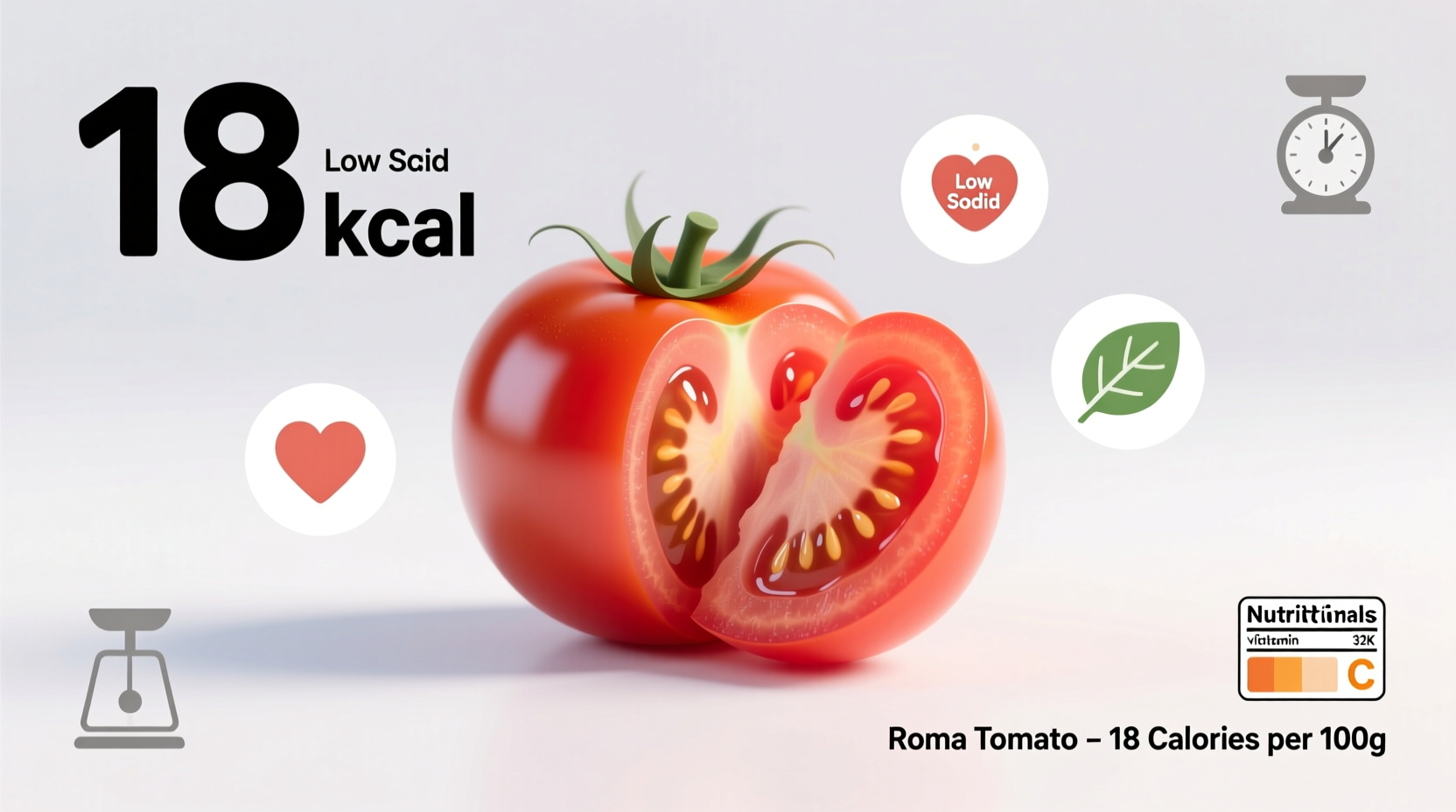Understanding the precise calorie count of common ingredients like roma tomatoes is essential for anyone managing their nutrition. Whether you're following a specific diet plan, counting macros, or simply making healthier food choices, having accurate nutritional information at your fingertips transforms how you approach meal planning.
Why Roma Tomato Calories Matter for Your Diet
Roma tomatoes, also known as plum tomatoes, have become kitchen staples for good reason. Their dense flesh and lower water content make them perfect for sauces, but their nutritional profile is equally impressive. With only 18 calories per medium tomato, they deliver substantial nutritional value without impacting your daily calorie budget significantly.
Registered dietitians consistently recommend incorporating low-calorie, nutrient-dense vegetables like roma tomatoes into daily meals. Their naturally low energy density means you can enjoy generous portions while staying within calorie goals—a principle supported by research from the US Department of Agriculture.
Complete Nutritional Profile of Roma Tomatoes
While calories are important, the full nutritional picture provides even more value. Here's what you get in a standard 100-gram serving of roma tomato:
| Nutrient | Amount | % Daily Value |
|---|---|---|
| Calories | 18 | 1% |
| Total Carbohydrate | 3.9g | 1% |
| Dietary Fiber | 1.2g | 4% |
| Sugar | 2.6g | n/a |
| Protein | 0.9g | 2% |
| Vitamin C | 14mg | 23% |
| Vitamin A | 833 IU | 17% |
| Lycopene | 25.7mg | n/a |
This comprehensive nutritional breakdown comes directly from the USDA FoodData Central database, the most authoritative source for nutritional information in the United States. The data reflects measurements taken from multiple samples to ensure accuracy across different growing conditions and seasons.
Roma Tomatoes vs. Other Varieties: Calorie Comparison
Not all tomatoes are created equal when it comes to calorie content. Understanding these differences helps you make informed choices based on your nutritional goals:
| Tomato Variety | Calories (per 100g) | Water Content | Best Uses |
|---|---|---|---|
| Roma (Plum) | 18 | 92% | Sauces, canning, salads |
| Globe (Standard) | 19 | 95% | Slicing, sandwiches |
| Cherry | 27 | 92% | Snacking, salads |
| Beefsteak | 19 | 94% | Burgers, sandwiches |
The slightly lower calorie count in roma tomatoes compared to standard varieties comes from their denser flesh and lower water content. This characteristic makes them particularly valuable for calorie-conscious cooking where you want maximum flavor with minimal volume.
Practical Applications: Using Roma Tomatoes in Your Meal Planning
Knowing the exact calorie count is just the beginning. Here's how to leverage this information in real-world scenarios:
Daily Calorie Budgeting
For those tracking calories, understanding serving sizes is crucial. Consider these common portions:
- One small roma tomato (60g): 11 calories
- One medium roma tomato (100g): 18 calories
- One large roma tomato (150g): 27 calories
- One cup diced roma tomatoes (180g): 32 calories
Cooking and Recipe Adjustments
When preparing sauces or cooked dishes, remember that cooking concentrates flavors but doesn't significantly change calorie content per gram. A cup of cooked roma tomato sauce contains approximately 70 calories, mostly from the natural sugars in the tomatoes.
Professional chefs like those at the Culinary Institute of America recommend roasting roma tomatoes to enhance their natural sweetness without adding calories—a technique that maximizes flavor while maintaining the vegetable's low-calorie advantage.

Factors That Influence Roma Tomato Nutrition
While the standard nutritional values provide reliable guidance, several factors can cause minor variations in calorie content:
- Growing conditions: Tomatoes grown in optimal sunlight develop higher sugar content, potentially increasing calories by 1-2 per 100g
- Ripeness level: Fully ripe roma tomatoes contain slightly more natural sugars than underripe ones
- Soil composition: Nutrient-rich soil can enhance vitamin density without significantly affecting calorie count
- Storage methods: Refrigeration can slightly reduce vitamin C content over time
These variations are minimal—typically less than 5%—so the standard 18 calories per 100g remains a reliable figure for nutritional planning. The Journal of Agricultural and Food Chemistry confirms that these natural fluctuations don't substantially impact the overall nutritional value for dietary planning purposes.
Health Benefits Beyond Calories
The true value of roma tomatoes extends far beyond their low calorie count. These nutritional powerhouses deliver significant health benefits:
- Lycopene content: Roma tomatoes contain higher concentrations of lycopene than many other varieties, a powerful antioxidant linked to reduced risk of heart disease
- Vitamin density: They provide substantial vitamin C and vitamin A in minimal calories
- Hydration support: With 92% water content, they contribute to daily hydration needs
- Dietary fiber: The 1.2g of fiber per 100g supports digestive health and promotes satiety
Nutrition researchers at Harvard's T.H. Chan School of Public Health emphasize that focusing solely on calories misses the bigger picture of nutritional value. Roma tomatoes exemplify how low-calorie foods can deliver disproportionate health benefits through their micronutrient profile.
Smart Ways to Incorporate Roma Tomatoes Into Your Diet
Maximize the nutritional benefits of roma tomatoes with these practical strategies:
- Add diced roma tomatoes to omelets for a nutrient boost without significant calories
- Use as a base for fresh salsa to replace higher-calorie condiments
- Roast with herbs for a flavorful, low-calorie side dish
- Blend into smooth soups for added nutrition and texture
- Create a simple bruschetta topping that enhances whole-grain toast
Dietitians recommend pairing roma tomatoes with healthy fats like olive oil to enhance absorption of fat-soluble nutrients like lycopene and beta-carotene. This simple technique maximizes nutritional benefits without substantially increasing calorie content.
Frequently Asked Questions
How many calories are in a small roma tomato?
A small roma tomato weighing approximately 60 grams contains about 11 calories. This makes them an excellent low-calorie snack option or addition to salads and other dishes when you're watching your calorie intake.
Are roma tomatoes good for weight loss?
Yes, roma tomatoes are excellent for weight loss due to their low calorie density (only 18 calories per 100g) and high water and fiber content. They provide volume and nutrients with minimal calories, helping you feel full while staying within your calorie goals.
Do cooked roma tomatoes have the same calories as raw?
The calorie content remains virtually identical when roma tomatoes are cooked. Cooking concentrates flavors but doesn't significantly change the calorie count per gram. One cup of cooked roma tomato sauce contains approximately 70 calories, similar to the raw equivalent before water reduction.
How do roma tomatoes compare nutritionally to other tomato varieties?
Roma tomatoes have slightly fewer calories (18 per 100g) compared to standard globe tomatoes (19 per 100g) due to their denser flesh and lower water content. They also contain higher concentrations of lycopene and other antioxidants, making them nutritionally superior for certain applications like sauces and cooked dishes.
Can I eat roma tomatoes on a low-carb diet?
Absolutely. Roma tomatoes contain only 3.9 grams of carbohydrates per 100 grams, with 1.2 grams coming from fiber. This results in just 2.7 net carbs per 100g, making them suitable for most low-carb and ketogenic diet plans when consumed in reasonable portions.











 浙公网安备
33010002000092号
浙公网安备
33010002000092号 浙B2-20120091-4
浙B2-20120091-4